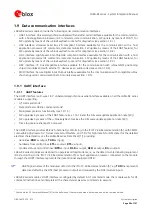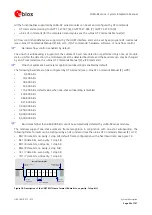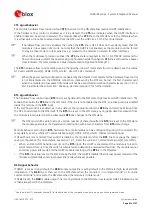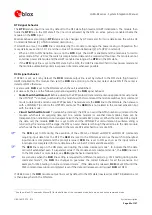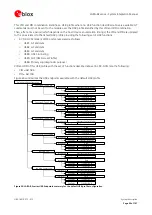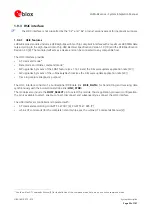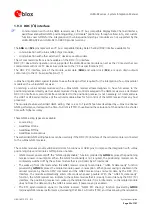
LARA-R2 series - System Integration Manual
UBX-16010573 - R12
System description
Page 42 of 157
DTR signal behavior
The
DTR
module input line is set by default to the OFF state (high level) at UART initialization. The module then
holds the
DTR
line in the OFF state if the line is not activated by the DTE: an active pull-up is enabled inside the
module on the
DTR
input.
Module behavior according to
DTR
status can be changed by AT command (for more details, see the
u-blox AT
Commands Manual
[2], AT&D command description).
If AT+UPSV=3 is set, the
DTR
line is monitored by the module to manage the power saving configuration (for
more details, see section 1.9.1.4 and the
u-blox AT Commands Manual
[2], AT+UPSV command):
When an OFF-to-ON transition occurs on the
DTR
input, the UART is enabled and the module is forced to
active mode. After ~20 ms, the switch is completed and data can be received without loss. The module cannot
enter low power idle mode and the UART is enabled as long as the
DTR
is in the ON state
If the
DTR
input line is set to the OFF state by the DTE, the UART is disabled (held in low power mode) and
the module automatically enters low power idle mode whenever possible
DCD signal behavior
If AT&C1 is set, as it is by default, the
DCD
module output line is set by default to the OFF state (high level) at
UART initialization. The module then sets the
DCD
line according to the carrier detect status: ON if the carrier is
detected, OFF otherwise.
For voice calls,
DCD
is set to the ON state when the call is established.
For data calls, there are the following scenarios regarding the
DCD
signal behavior:
Packet Switched Data call
: Before activating the PPP protocol (data mode) a dial-up application must provide
the ATD*99***<context_number># to the module: with this command the module switches from command
mode to data mode and can accept PPP packets. The module sets the
DCD
line to the ON state, then answers
with a CONNECT to confirm the ATD*99 command. The
DCD
ON is not related to the context activation but
with the data mode.
Circuit Switched Data call
: To establish a data call, the DTE can send the ATD<number> command to the
module which sets an outgoing data call to a remote modem (or another data module). Data can be
transparent (non reliable) or non transparent (with the reliable RLP protocol). When the remote DCE accepts
the data call, the module
DCD
line is set to ON and the CONNECT <communication baudrate> string is
returned by the module. At this stage, the DTE can send characters through the serial line to the data module
which sends them through the network to the remote DCE attached to a remote DTE
The
DCD
is set to ON during the execution of the +CMGS, +CMGW, +USOWR, +USODL AT commands
requiring input data from the DTE: the
DCD
line is set to the ON state as soon as the switch to binary/text
input mode is completed and the prompt is issued;
DCD
line is set to OFF as soon as the input mode is
interrupted or completed (for more details see the
u-blox AT Commands Manual
[2]).
The
DCD
line is kept in the ON state, even during the online command mode
13
, to indicate that the data
call is still established even if suspended, while if the module enters command mode
, the
DSR
line is set
to the OFF state. For more details, see
signal behavior description.
For scenarios when the
DCD
line setting is requested for different reasons (e.g. SMS texting during online
command mode
), the
DCD
line changes to guarantee the correct behavior for all the scenarios. For
example, for SMS texting in online command mode
, if the data call is released,
DCD
is kept ON until the
SMS command execution is completed (even if the data call release would request
DCD
set OFF).
If AT&C0 is set, the
DCD
module output line is set by default to the ON state (low level) at UART initialization and
is then always held in the ON state.
13
See the
u-blox AT Commands Manual
[2] for the definition of the command mode, data mode, and online command mode











